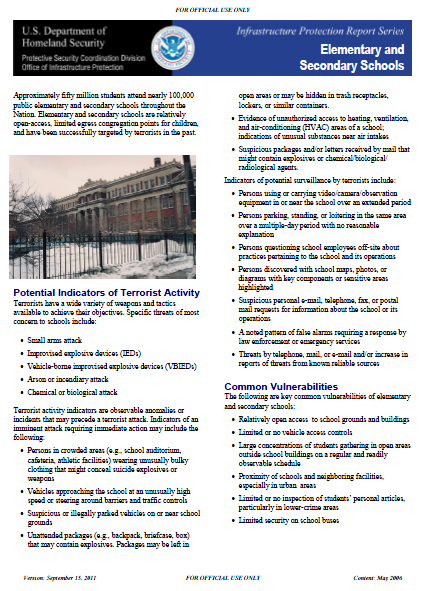DHS Infrastructure Protection Report Series
- 2 pages
- For Official Use Only
- September 15, 2011
Approximately fifty million students attend nearly 100,000 public elementary and secondary schools throughout the Nation. Elementary and secondary schools are relatively open-access, limited egress congregation points for children, and have been successfully targeted by terrorists in the past.
Potential Indicators of Terrorist Activity
Terrorists have a wide variety of weapons and tactics available to achieve their objectives. Specific threats of most concern to schools include:
- Small arms attack
- Improvised explosive devices (IEDs)
- Vehicle-borne improvised explosive devices (VBIEDs)
- Arson or incendiary attack
- Chemical or biological attack
Terrorist activity indicators are observable anomalies or incidents that may precede a terrorist attack. Indicators of an imminent attack requiring immediate action may include the following:
- Persons in crowded areas (e.g., school auditorium, cafeteria, athletic facilities) wearing unusually bulky clothing that might conceal suicide explosives or weapons
- Vehicles approaching the school at an unusually high speed or steering around barriers and traffic controls
- Suspicious or illegally parked vehicles on or near school grounds
- Unattended packages (e.g., backpack, briefcase, box) that may contain explosives. Packages may be left in open areas or may be hidden in trash receptacles, lockers, or similar containers.
- Evidence of unauthorized access to heating, ventilation, and air-conditioning (HVAC) areas of a school; indications of unusual substances near air intakes
- Suspicious packages and/or letters received by mail that might contain explosives or chemical/biological/ radiological agents.
Indicators of potential surveillance by terrorists include:
- Persons using or carrying video/camera/observation equipment in or near the school over an extended period
- Persons parking, standing, or loitering in the same area over a multiple-day period with no reasonable explanation
- Persons questioning school employees off-site about practices pertaining to the school and its operations
- Persons discovered with school maps, photos, or diagrams with key components or sensitive areas highlighted
- Suspicious personal e-mail, telephone, fax, or postal mail requests for information about the school or its operations
- A noted pattern of false alarms requiring a response by law enforcement or emergency services
- Threats by telephone, mail, or e-mail and/or increase in reports of threats from known reliable sources
Common Vulnerabilities
The following are key common vulnerabilities of elementary and secondary schools:
- Relatively open access to school grounds and buildings
- Limited or no vehicle access controls
- Large concentrations of students gathering in open areas outside school buildings on a regular and readily observable schedule
- Proximity of schools and neighboring facilities, especially in urban areas
- Limited or no inspection of students’ personal articles, particularly in lower-crime areas
- Limited security on school buses
Protective Measures
Protective measures include equipment, personnel, and procedures designed to protect a facility against threats and to mitigate the effects of an attack. Protective measures for elementary and secondary schools include:
Planning and Preparedness
- Designate an employee as security director to develop, implement, and coordinate all security-related activities
- Conduct security audits on a regular and continuing basis. Develop a comprehensive security plan and emergency response plan for the school
- Conduct regular exercises of emergency plans
- Establish liaison and regular communication with local law enforcement and emergency responders
Personnel
- Conduct background checks on all school employees
- Incorporate security into employee training programs
- Provide security information and training to all students
Access Control
- Define the facility perimeter and areas within the facility that require access control. Maintain building access points to the minimum needed
- Issue photo identification badges to all school employees and students
- Require visitors check in with the front office upon arrival and departure
- Provide visitors with school issued identification badges when on school grounds.
- Positively identify all vehicles and drivers that enter the school parking lots
- Institute a policy restricting other vehicles from accessing the bus-loading zone
- Secure ladders, awnings, and parapets that provide access to building roofs, HVAC systems, and other critical equipment
Barriers
- Install appropriate perimeter barriers and gates. Maintain clear area at perimeter barriers to enable continuous monitoring and to inhibit concealment of people or packages
- Establish a clear zone adjacent to buildings. Keep zone free of vegetation and other obstructions
- Install barriers to protect doors and windows from small arms fire and explosive blast effects
Communication and Notification
- Install system(s) that provide communication with all people at the school, including employees, students, emergency response teams, and visitors
- Develop a plan for communicating with parents during emergency situations
- Develop a notification protocol that outlines who should be contacted in emergencies.
- Develop a procedure for communicating with the public and the media regarding security issues
Monitoring, Surveillance, Inspection
- Evaluate needs and design a monitoring, surveillance, and inspection program
- Provide visual surveillance capability (e.g., designated surveillance points, cleared lines of sight)
- Install intrusion detection and alarm systems
- Deploy personnel assigned to security duty to regularly inspect sensitive or critical areas
- Continuously monitor all people entering and leaving the facility for suspicious behavior
- Continuously monitor all vehicles approaching the facility for signs of threatening behavior
Infrastructure Interdependencies
- Ensure that the school has adequate utility service capacity to meet normal and emergency needs
- Ensure that employees are familiar with how to shut off utility services
- Provide adequate physical security for utility services
Cyber Security
- Develop and implement a security plan for computer and information systems hardware and software
- Maintain a well-trained computer security staff
- Incident Response
- Ensure that an adequate number of emergency response personnel are on duty and/or on call
- Provide training and equipment to emergency response personnel to enable them to deal with terrorist-related incidents
- Check the status of all emergency response equipment and supplies on a regular basis
- Develop a plan for discharging students following incident resolution

